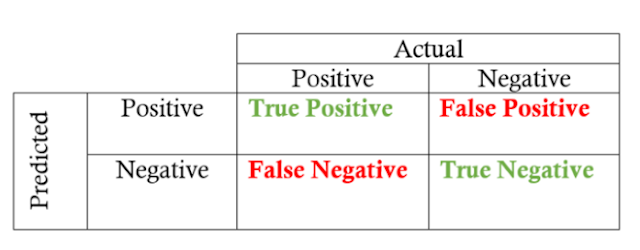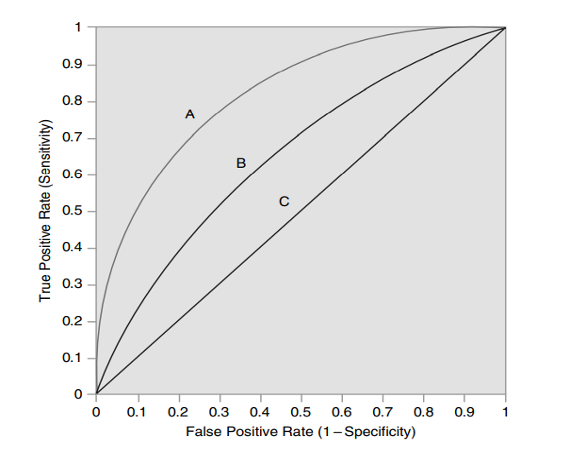Understand common-used Evaluations Metrics for Binary Classification
This blog is based on the content of:
[1] Olson, David L., and Dursun Delen. Advanced data mining techniques. Springer Science & Business Media, 2008.
[2] Géron, Aurélien. Hands-on machine learning with Scikit-Learn, Keras, and TensorFlow: Concepts, tools, and techniques to build intelligent systems. O'Reilly Media, 2019.
[3] Davis, Jesse, and Mark Goadrich. "The relationship between Precision-Recall and ROC curves." Proceedings of the 23rd international conference on Machine learning. 2006.
[4] Schütze, H., Manning, C. D., & Raghavan, P. (2008). "Chapter 8: Evaluation in information retrieval" Introduction to information retrieval (Vol. 39, pp. 234-265). Cambridge: Cambridge University Press.
---------------------------------------------------
This blog aims to summarize the common used evaluations metrics for binary classification with particular emphasis on class imbalance problems.
Let's start by understanding the confusion matrix.
Confusion Matrix
Positive/Negative: based on prediction result
Positive: predict Positive
Negative: predict Negative
True/False: based on actual label
True: the prediction is correct
False: the prediction is wrong
To understand each term in confusion matrix, we first look at Positive/Negative according to the prediction result, add True/False in the front then according to the actual label:
- True Positive (TP): Predict Positive and the prediction is Correct (Positive in real case)
- False Positive (FP): Predict Positive but the prediction is False (Negative in real case)
- True Negative (TN): Predict Negative and the prediction is Correct (Negative in real case)
- False Negative (FN): Predict Negative but the prediction is False (Positive in real case)
Accuracy
Accuracy is the proportion of true results among the total number of cases examined. It is used when the classes are well balanced.
- Accuracy Paradox. High Accuracy might be too crude to be useful. For example, in a dataset which contains 99 normal samples and 1 anomaly. If a model predicted all as ‘normal’. Then this model has a 99% accuracy but useless to detect anomaly.Precision and Recall are more useful in class imbalance (skewed dataset) cases.
- Precision VS Accuracy. Precision focuses only on the instances that are predicted Positive. Accuracy considers both instances that are predicted Positive and Negative.
Recall
The proportion of actual Positives that is correctly classified.
Precision-Recall Curves
- Threshold. Classifiers compute a score [class probability] for each instance and if that score is greater than threshold, it assigns the instance to the positive class, otherwise it assigns the instance to the negative class. So we we calculate the precision and recall of a classifier, we are actually calculating precision and recall of this classifier in a certain threshold (by default is 0.5).
By varying the threshold value, we obtains a set of Precision/Recall pairs. Plotting all the Precision/Recall pairs in to a graph we get a Precision-Recall curve.
One functionality of the Precision-Recall curve is to find the threshold that best serves our need.
F1-Score
It is convenient to combine Precision and Recall into a single metric ‘F1-score’.
F1-score is the ‘Harmonic Mean’ of Precision and Recall. Compared to ‘Arithmetic Mean’, ‘Harmonic Mean’ penalizes more the case when one’s value is much lower than another.
As a result, to get a high F1-score, both Precision and Recall need to be high.
However, depending on the application scenario, the highest F1-score might not be the best solution. For example, in anomaly detection, you might want to detect all the actual anomalies (high recall) even though many normal instances might be misclassed to the anomaly class (low precision).
Apart from the Precision-Recall curve, Receiver Operating Characteristics (ROC) curve is another permanence evaluation technique for classification models.
ROC curves have long been used in signal detection theory to depict the trade-off between hit rate and false alarm rates of classifiers. Compared with the Precision-Recall curve, the ROC curve is not influenced by the skew in the class distribution, which will be demonstrated later.
A few metrics to be introduced before reaching ROC curves:
Sensitivity and Specificity
True Positive Rate (TPR) and False Positive rate(FPR)
True Positive Rate:
False Positive Rate:
TPR and FPR are not influenced by the skew in class distribution
From a Conditional Probability point of view:
Assume :
- 1 corresponds to Positive class
- 0 correspond to Negative class.
- X is the predicted class label
- Y is the actual class label .
Then:
- Precision = P(Y=1|X=1)
- FPR= Recall = Sensitivity = P(X=1|Y=1)
- TPR = 1 - Specificity = 1 -P(X=0|Y=0)
The ROC curve is plotted by traversing all thresholds with TPR on the Y axis and FPR on the X axis.
Several points to note in the graph:
- Lower left (0,0): Never issuing a positive classification. (Assigning all to negative class)
- Upper right (1,1): Unconditionally issuing positive classification. (Assigning all to positive class)
- Upper left (0,1): Perfect Classification. More the curve is close to the upper left point (0,1), the better the classifier is. So in this ROC graph, A is the most performant classifier, followed by B , and then C [2].
- AUC. AUC is the abbreviation of Area Under Curve. Here AUC stands for the AUC of ROC curves but similarly there is also AUC for P-R curves. The value of AUC curves varies in [0,1], which a perfect classifier gets a value of 1. The diagonal line (C in the graph) stands for the strategy of randomly guessing a class (AUC = 0.5). As ROC curves are the measures regardless of skew in class distribution, AUC is a measure of models’ classification performance regardless of both skew in the class distribution and threshold.
- Visualization.I strongly encourage you to check this article who did a amazing visualization about ROC curve: https://www.spectrumnews.org/opinion/viewpoint/quest-autism-biomarkers-faces-steep-statistical-challenges/
ROC vs Precision-Recall Curve
Assume :
- 1 corresponds to Positive class
- 0 correspond to Negative class.
- X is the predicted class label
- Y is the actual class label .
P-R curve consists of:
- Precision = P(Y=1|X=1)
- Recall = FPR = Sensitivity = P(X=1|Y=1)
ROC curve consists of:
- TPR = 1 - Specificity = 1 - P(X=0|Y=0)
- FPR = Recall = Sensitivity = P(X=1|Y=1)
‘‘ROC curve present an overly optimistic view of an algorithm’s performance if there is a large skew in the class distribution’’
‘‘For any dataset, the ROC curve and PR curve for a given algorithm contain the same points. This equivalence leads to the surprising theorem that a curve dominates in ROC space if and only if it dominates in PR space. [...] Finally, we show that an algorithm that optimizes the area under the ROC curve is not guaranteed to optimize the area under the PR curve.’’


















Comments
Post a Comment